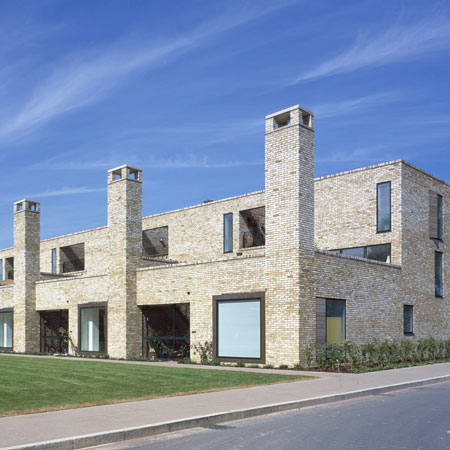
Accordia wins Stirling Prize
Accordia, a housing development by architects Feilden Clegg Bradley Studios, Alison Brooks Architects and Macreanor Lavington, has won the RIBA Stirling Prize 2008 for the best building by a British architect.
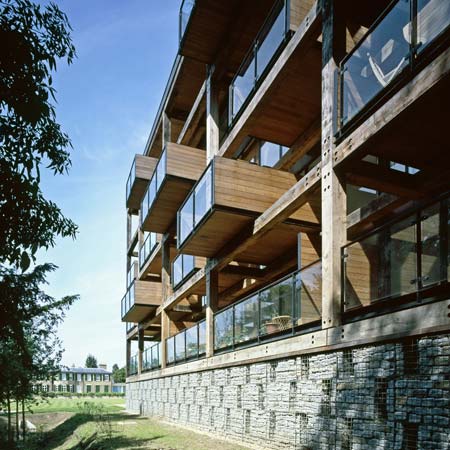
Accordia, a development at Cambridge, England, beat five other shorlisted schemes by architects Grimshaw, Denton Corker Marshall, Zaha Hadid Architects, Allies & Morrison and Allford Hall Monaghan Morris to the £20,000 prize.
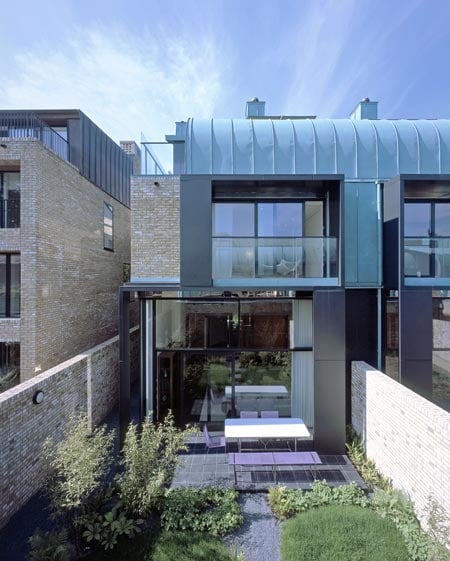
See all the shortlisted projects in our earlier story. All above images are copyright Tim Crocker.
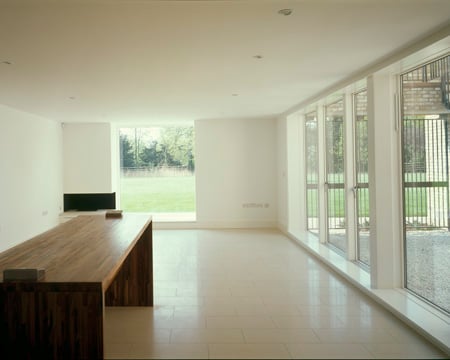
Above image is copyright Peter Cook.
Here's some info about the Stirling Prize winner and the winners of other RIBA awards:
--
Accordia wins prestigious RIBA Stirling Prize 2008
Accordia in Cambridge designed by Feilden Clegg Bradley Studios, Alison Brooks Architects and Macreanor Lavington has won the 13th RIBA Stirling Prize in association with The Architects' Journal. The presentation of the UK's premier architectural award took place at a glittering award ceremony this evening (Saturday 11 October) at the Arena and Convention Centre, Liverpool, and was televised live on Channel 4 at 9pm.
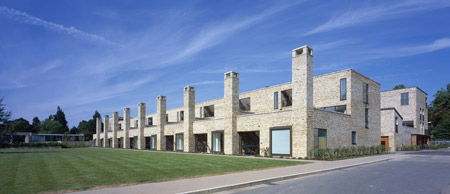
The judges commented:
“This is high density housing at its very best, demonstrating that volume house-builders can deliver high quality architecture – and that as a result they can improve their own bottom line. The whole scheme is about relationships: between architect and developer/contractor/client; between three very different firms of architects – Feilden Clegg Bradley, Maccreanor Lavington and Alison Brooks Architects; and between private and public external spaces, providing a new model for outside-inside life with interior rooftop spaces, internal courtyards and large semi-public community gardens.”
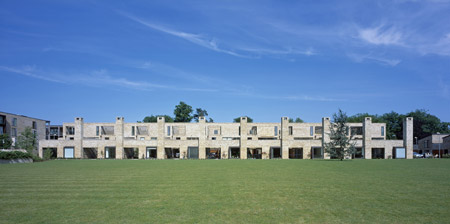
On a brownfield site in Cambridge – formerly owned by the military - beautifully thought-through houses at a density of 47 homes to the hectare (65 if you discount the generous amenity spaces). The site is organized straddling a broad avenue with just the one entrance for residents allowed to the site by the planners. In this they bowed to the wishes of local residents for whom objection appears to be a full time occupation.

In other matters, the planners led by the remarkable Peter Studdert have been imaginative and firm with objectors. How often do planners use their powers to withhold permission unless the developers use good architects to produce fine architecture? What other authority would have allowed terraces at first and second floor level, instead of banning them on grounds of over-looking? Where else would house-builders have been dissuaded from bowing to the supposed need of homeowners for a minimum 15 metre strip of garden behind the house?

Here several busy residents spoke to judges about their sense of liberation from the demands of gardening. Instead there is common land where children safely play as if in some idyllic throwback to the 1950s. Houses and flats have good-sized, well-proportioned rooms with views out ranging from urban to rural pasture.
There is plenty of variety in the house-plans too, from the understated simplicity of the FCBS layouts, to the highly complex plans of Maccreanor Lavington with their two staircases and their ambiguous inside-outside spaces; and the scissor plan stairs in some of the Alison Brooks houses. The detailing too varies with the architect, producing a different aesthetic in each. These are traditional houses but with a twist. Much of the construction was fabricated off site to increase speed of construction, reduce waste, and to improve site safety and environmental performance.
The judges were asked to consider Phase 1 of the scheme – filling the northern and western parts of the site – since then Countryside have sold on to Redeham Homes to complete the scheme and to date at least the new developers and their architects have remained faithful both to the Feilden Clegg Bradley masterplan and to their detailed design guidelines. One row of mews houses by the new architects was indistinguishable, from the FCBS original on the other side of the exquisitely planted landscaping.
This is a Span-type housing for the 21st century, a post-Thatcherite development that is not afraid of communal aspirations and aesthetics. There is plenty of individuality in the flexible house plans (mews garages have often been turned into studios or offices, even granny annexes); there is privacy on (most of) the terraces and balconies; but there are village greens and strips of common land, cars are tamed not banned – this is architecture that treats adults as grown-ups and children as people with different needs: for stimuli for play which does not involved sitting into front of a screen or a games console, and which involves interaction with other young people, not with Bill Gates and his protégés.
The development proves that good modern housing sells, that a committed local authority can have a very positive influence on the design, that a masterplan with a range of architects can be successful and that the very best architecture does not need to rely on gimmicks. It has already won numerous awards: Housing Design Awards – overall winner (2006); Building for Life Awards: Gold Standard (2006); National Homebuilder Design Awards (2006); Civic Trust (2007). It is a project that will be much referred to and used a future case study. It is architecture which gives hope for us all for the future.”
Sunand Prasad, RIBA President, announced the winner and Kieran Long, Editor of The Architects' Journal presented with the prize and a cheque for £20,000.
Accordia beat off stiff competition from five other outstanding contenders: Amsterdam Bijlmer Arena Station, Amsterdam, Netherlands – Grimshaw and ARCADIS Architecten; Manchester Civil Justice Centre, Manchester - Denton Corker Marshall; Nord Park Cable Railway, Innsbruck, Austria – Zaha Hadid Architects; Royal Festival Hall, London - Allies and Morrison and Westminster Academy at the Naim Dangoor Centre, London - Allford Hall Monaghan Morris.
The RIBA Stirling Prize jury, comprising architecture specialists and lay judges visited all six shortlisted buildings and then met for a final time this afternoon to pick the winner. The judges were Eva Jiricna architect, Eva Jiricna Architects; Gordon Murray – architect, Murray Dunlop Architects; Shelley McNamara – architect, Grafton Architects; Kieran Long – Editor, The Architects’ Journal and Diarmuid Gavin – garden designer, Diarmuid Gavin Designs.
This is the 13th year the RIBA Stirling Prize has been presented. Last year's winner was the Museum of Modern Literature by David Chipperfield Architects.. The previous winners are: Barajas Airport in Madrid by Richard Rogers Partnership, The Scottish Parliament, designed by EMBT / RMJM, 30 St. Mary Axe by Foster and Partners; the Laban Centre, London by Herzog & de Meuron; Gateshead Millennium Bridge by Wilkinson Eyre; Magna, Rotherham by Wilkinson Eyre; Peckham Library and Media Centre by Alsop and Störmer; the NatWest Media Centre at Lord's Cricket Ground by Future Systems; the American Air Museum at Duxford by Foster and Partners; The Music School, Stuttgart by Michael Wilford and Partners; and the Centenary Building, University of Salford, by Hodder Associates.
The RIBA Special Awards honour the best buildings with special emphasis on: sustainable and inclusive design; conservation; exemplary school design, a one-off home and a project working within a smaller budget. The following winners of the RIBA Special Awards were also announced and presented at the ceremony this evening:
Oxley Woods, in Milton Keynes, won the Manser Medal sponsored by the Rooflight Company for the best one-off house or housing scheme designed by an architect in the UK.
The Sackler Crossing in Kew by David Sheppard Architects won the Stephen Lawrence Prize sponsored by the Marco Goldschmied Foundation, for the best example of a building with a construction budget of less than £1 million.
The Old Market Square, Nottingham by Gustafson Porter won the inaugural RIBA CABE Public Space Award which celebrates publicly accessible external space.
St Pancras International by Alastair Lansley (for Union Railways) won The Crown Estate Conservation Award. The prize is awarded to the best work of conservation which demonstrates successful restoration or adaptation of an architecturally significant building.
The Manchester Civil Justice Centre, Manchester by Denton Corker Marshall won the RIBA Sustainability Award sponsored by English Partnerships. The prize is given to the building that demonstrates most elegantly and durably the principles of sustainable architecture.
Westminster Academy at the Naim Dangoor Centre by Allford Hall Monaghan Morris won the Sorrell Foundation Schools Award, was presented to the architects of the best RIBA award-winning school - primary or secondary - with the aim of raising the standards of design in all new school building.
For job opportunities at Feilden Clegg Bradley Studios, visit their company profile on Dezeen Jobs.